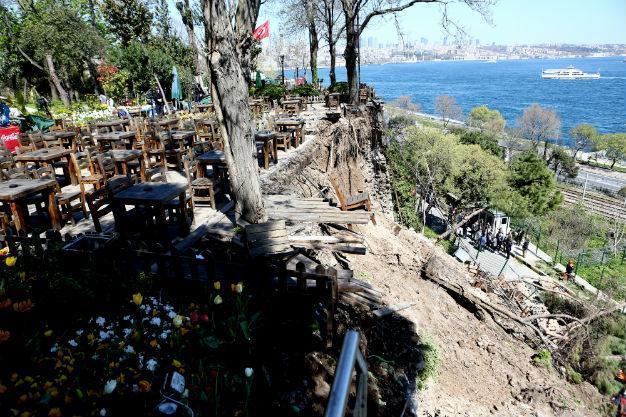Topkapı Palace must be reinforced, expert warns
Yenal Bilgici - ISTANBUL

AA photo
Following the collapse of a wall in Istanbul’s historic Gülhane Park, which killed two people and injured five others, İlber Ortaylı, the former director of Topkapı Palace Museum, said alarm bells were ringing for the entire compound unless a thorough reinforcement project started immediately.
An expert who knows the complex extremely well, Ortaylı pointed out that the historic Gülhane Park, a green area between the Marmara Sea and the city’s Sirkeci neighborhood, used to be the private garden of the sultans residing in Topkapı Palace. Ortaylı said, “It is surrounded and protected by what is called an imperial wall. If you approach the garden from the Sarayburnu direction, you should cross the railroad and on your left there is a tea garden, a cafe on a hilltop. This café is famous because of its easy access. You can enjoy the view.”
The wall that collapsed last week was right below this tea garden.
Ortaylı said one side of the wall, the one closer to Topkapı Palace, was 25 meters high. “That wall is a supporting wall, built for the purpose of holding the earth behind. Both the 25-meter-high part and the other lower part were built as a masonry wall. The problem starts there. It is not a wall of cut stones connected to each other. Its width is about one meter or one and a half meters. It is an inadequate supporting wall, filled with loose colluvial soil. Apparently, trees have grown there and the roots of these trees have damaged the wall.”
Another problem according to Ortaylı is that the wall is not properly maintained, as a section of the wall is under the responsibility of the municipality but the wall extends inside Topkapı Palace. “There are problems in military storage facilities built in the 19th century. Chief experts in Turkey have voluntarily examined Topkapı against any possible damage during an earthquake. Now, only the southwest side is being repaired. The collapse of the wall shows the huge risk. Alarm bells are ringing.”
Even if it costs millions of dollars, the reinforcement of the palace should be done, and should begin immediately, Ortaylı warned. “The lower parts of the palace should absolutely be closed, encircled and repaired. The park should also be considered. The material used in the wall does not belong from the time of the sultans. At the time of the Ottoman sultans, such an unsound, unstable wall would not have been built.”
After the sultans left the palace, most probably after 1860, some top civil servants used the palace, according to the professor. Ortaylı also said, “This rather weak wall was built at the beginning of the 20th century... It obviously cannot support the earth behind it.”
Ortaylı also drew attention to the traffic at Sarayburnu, which he thinks is damaging to the palace complex.
“All of these structures constitute a danger for the palace. Except for the historic Sirkeci train station, all other [nearby] buildings should be removed. The road should be closed. It is dangerous. The railroad is also dangerous.”
Ortaylı also said the underground Marmaray tunnel, a metro line which passes under the Bosphorus and connects Istanbul’s European and Asian sides, has to be dealt with. “The Marmaray is troublesome for Topkapı Palace. It is a huge mistake that the Marmaray approaches the surface near the palace. Just like the ugly bridge in Haliç [the Golden Horn] it is a failure of Turkish engineers. Building a metro under the Süleymaniye Mosque is redundant and shameful. Also the Hagia Irene Museum is now used for concerts. If I were one of the organizers, I would not step foot in there. It is a building almost 1,000 years old. It needs restoration. It should be closed to huge organizations.”
